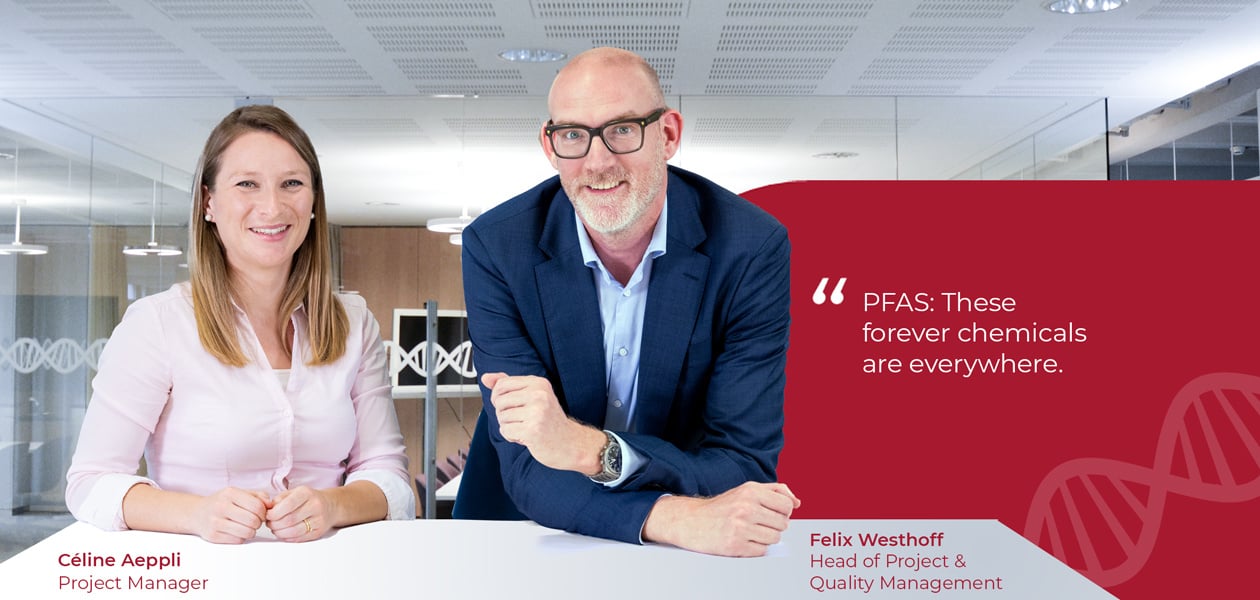Future of PFAS in IVD Instrument Development

Posted by:
Céline Aeppli
Published on:
Nov 21, 2024
In 2025, a decision on the proposal for restriction of a wide range of per- and polyfluoroalkyl substances (PFAS) under the REACH regulation is expected.
If the restriction proposal is adopted, this could significantly impact IVD (in vitro diagnostic) instrument development. Manufacturers of IVD instruments may need to act quickly if they want to continue selling their instruments in the EU market in compliance with the newly introduced regulations.
Read on for an overview of the current PFAS regulations, potential implications of the newly proposed restrictions, and what you can do to stay ahead of the evolving regulations.
PFAS – The forever chemicals [1]
Tubing, seals, O-rings, and valves are essential components in IVD instruments. These parts must withstand exposure to a variety of chemicals used in the applications, fluctuating temperatures, and aging effects to ensure long-term instrument durability. As a result, materials that meet these stringent requirements are carefully selected. In a lot of cases, the most famous PFAS, with the brand name “Teflon™”, is utilized, either as a component or as a coating due to its unique chemical and physical properties.
PFAS are often referred to as “forever chemicals” as they are characterized by a very strong carbo-fluorine bond, which makes the material highly resistant to degradation. This unique property makes PFAS advantageous for numerous applications. However, this same stability leads to prolonged environmental persistence, followed by continuous release into the environment, affecting humans and other species.
As PFAS degrade, they can pollute ground/drinking water and accumulate in humans, animals, and plants causing toxic effects. For example, they can cause cancer or interfere with the endocrine (hormonal) system.
Due to increasing awareness of the negative environmental and health impact of PFAS, as well as the very difficult and costly disposal process, regulations are being enforced and continuously expanded.
It’s vital that manufacturers of IVD instruments take action now
to maintain market access.
Globally regulated PFAS [1] [2]
Some PFAS are globally regulated via the Stockholm Convention, which regulates the Persistent Organic Pollutants (POPs) list. The following PFAS fall under this regulation and measures must be taken to restrict or ban production of these PFAS.
- Perfluorooctane sulfonic acid and its derivatives (PFOS) have been restricted for >10 years
- Perfluorooctanoic acid (PFOA), its salts, and PFOA-related compounds have been banned since 2020
- Perfluorohexanesulfonic acid (PFHxS), its salts, and related compounds have been banned since August 2023
- Long-chain perfluorinated carboxylic acids (C9-21 PFCAs) are currently being considered for regulation
PFAS regulations in the EU [1] [2]
In the EU, PFAS are regulated via the REACH regulation, in addition to the POP regulation, which are both in place to protect human health and the environment. The following PFAS fall under the REACH regulation, of which three of them fall under the “substances of very high concern” (SVHC) of the REACH regulation.
|
Regulation |
Substance |
|
REACH substances of very high concern (SVHC) [3] |
2,3,3,3-tetrafluoro-2-(heptafluoropropoxy)propionic acid, its salts, and its acyl halides (HFPO-DA), a short-chain PFAS substitute for PFOA in fluoropolymer production |
|
Perfluorobutane sulfonic acid (PFBS) and its salts, an alternative to PFOS |
|
|
Perfluoroheptanoic acid (PFHpA) and its salts |
|
|
REACH Regulation |
Perfluorinated carboxylic acids (C9-14 PFCAs), their salts and precursors, restricted since February 2023 |
|
Proposed restriction under REACH Regulation |
Undecafluorohexanoic acid (PFHxA) |
|
Restriction for PFAS in firefighting foam |
|
|
European Food Safety Authority |
In drinking water, limits for all PFAS have been in place since 2021 |
|
Safety threshold introduced for the main perfluoralkyl substances (PFOA, PFOS, PFNA, and PFHxS) which accumulate in the body |
The SVHC were implemented in 2019, 2020, and 2023. When using PFAS from the SVHC lists in products, the manufacturers and importers need to declare the existence of these substances. Furthermore, they are required to notify customers if the presence of SVHC in their products exceeds 0.1% by weight and provide instructions on safe use of the product.
A proposal covering a wide range of PFAS was submitted to ECHA (European Chemical Agency) in January 2023, which is currently being reviewed, discussed, and evaluated by different committees [3]. It proposes the restriction of manufacturing, placement on the market as well as the use of PFAS.
The proposed restriction includes two options: either a full ban or a use-specific ban with derogations. The decision if a proposal option is being implemented is planned to be made in 2025. This could become effective in 2026/27 at the earliest (18 months after entry into force).
PFAS regulation in the US [4]
Although the U.S. has not ratified the Stockholm Convention, the Environmental Protection Agency (EPA) enforces key PFAS regulations under the Toxic Substances Control Act (TSCA) [5].
Since 2011, former and current manufacturers of PFAS-containing products, including IVD instruments, are required to report information on the use, production volumes, disposal, and associated risks of these substances. This reporting ensures transparency and enables oversight by the EPA.
Further, the Significant New Use Rules (SNURs) empower the EPA to monitor and restrict new uses of PFAS in medical devices, including IVD instruments, if deemed necessary to protect public health. These rules help ensure that any new application of PFAS undergoes a rigorous review before approval.
Expected impact on IVD instrument development [3]
The upcoming decision in 2025 regarding the proposal submitted to the ECHA in January 2023 will be highly significant for manufacturers developing and supplying instruments to the EU. This is due, in particular, to the broad scope of PFAS restrictions it encompasses. If the proposal is implemented, the immediate impact will depend on the option and extent to which the content of the proposal will be implemented.
If the option for a complete ban is enforced, industries will have 18 months to adapt to the new regulations. This would imply a full replacement of components in instruments, which contain PFAS listed in the proposal.
If a use-specific ban with derogations is implemented, the transition period to be compliant with the new regulation will vary across industries, ranging from 18 months to 12 years (e.g., implantable medical devices).
Independent of the upcoming decision in 2025, the direction of the legislators is clear – regulations will be passed soon, aiming to reduce PFAS usage to a minimum, limiting it only to cases where it is deemed irreplaceable and essential for society. Therefore, manufacturers and distributors of IVD instruments are advised to invest early in:
- Analysis of their instruments to identify where PFAS is used
- Identification of PFAS alternatives
- Testing of PFAS alternatives to guarantee the replacement without decrease in quality and safety
- Re-verification/validation of their IVD instruments to ensure compliance once the regulations are implemented, allowing continued market access
References
|
[1] |
"ECHA - European Chemicals Agency," [Online]. Available: https://echa.europa.eu/de/hot-topics/perfluoroalkyl-chemicals-pfas. |
|
[2] |
"Stockholm Convention on Persistent Organic Pollutants (POPs)," [Online]. Available: https://www.pops.int/TheConvention/ThePOPs/AllPOPs/tabid/2509/Default.aspx. |
|
[3] |
"ECHA - European Chemicals Agency," [Online]. Available: https://echa.europa.eu/de/-/echa-publishes-pfas-restriction-proposal. |
|
[4] |
"EPA - United States Environmental Protection Agency," [Online]. Available: https://www.epa.gov/assessing-and-managing-chemicals-under-tsca/tsca-section-8a7-reporting-and-recordkeeping. |
|
[5] |
"U.S. Department of State," [Online]. Available: https://www.state.gov/key-topics-office-of-environmental-quality-and-transboundary-issues/stockholm-convention-on-persistent-organic-pollutants/. |
|
Trademark: Teflon™ is a trademark of The Chemours Company FC, LLC. |
|

How we can help you stay ahead of the new regulations
If you are unsure whether your automated systems will comply with the upcoming PFAS regulations, you want to develop a new PFAS-free IVD instrument, or you need to find PFAS alternatives, we can help you achieve sustainable automated systems.
Contact Céline Aeppli (Project Manager) or Felix Westhoff (Head of Project and Quality Management) and discover how our deep application knowledge and technical expertise can help you maintain compliance.

